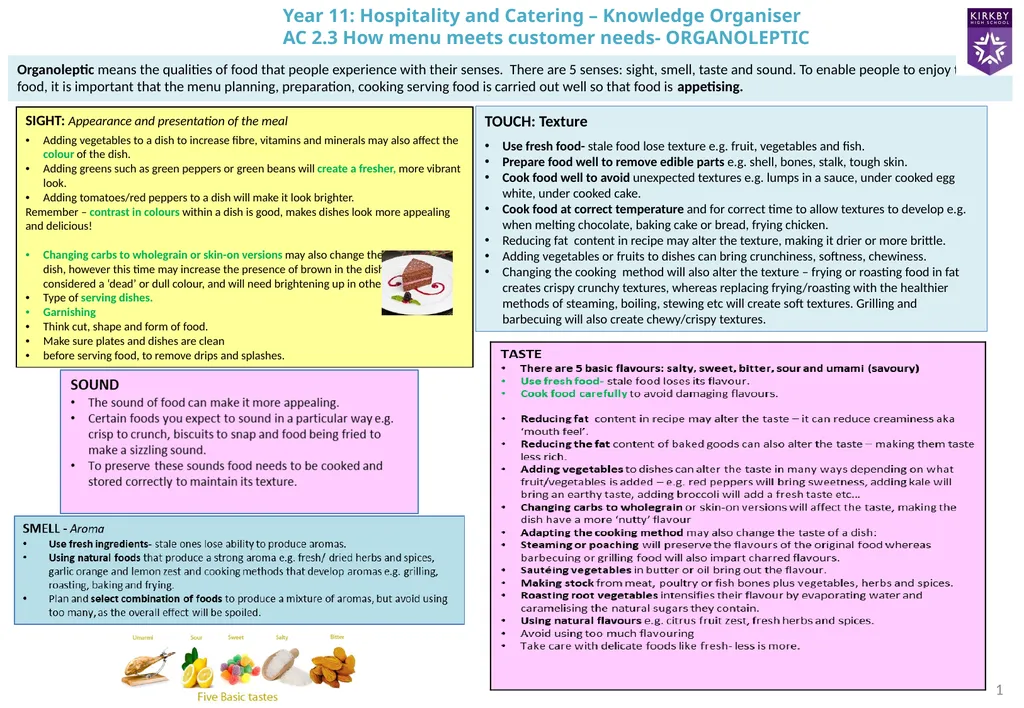1 Year 11: Hospitality and Catering – Knowledge
Author : min-jolicoeur | Published Date : 2025-05-13
Description: 1 Year 11 Hospitality and Catering Knowledge Organiser AC 23 How menu meets customer needs ORGANOLEPTIC Organoleptic means the qualities of food that people experience with their senses There are 5 senses sight smell taste and
Presentation Embed Code
Download Presentation
Download
Presentation The PPT/PDF document
"1 Year 11: Hospitality and Catering – Knowledge" is the property of its rightful owner.
Permission is granted to download and print the materials on this website for personal, non-commercial use only,
and to display it on your personal computer provided you do not modify the materials and that you retain all
copyright notices contained in the materials. By downloading content from our website, you accept the terms of
this agreement.
Transcript:1 Year 11: Hospitality and Catering – Knowledge:
1 Year 11: Hospitality and Catering – Knowledge Organiser AC 2.3 How menu meets customer needs- ORGANOLEPTIC Organoleptic means the qualities of food that people experience with their senses. There are 5 senses: sight, smell, taste and sound. To enable people to enjoy their food, it is important that the menu planning, preparation, cooking serving food is carried out well so that food is appetising. TOUCH: Texture Use fresh food- stale food lose texture e.g. fruit, vegetables and fish. Prepare food well to remove edible parts e.g. shell, bones, stalk, tough skin. Cook food well to avoid unexpected textures e.g. lumps in a sauce, under cooked egg white, under cooked cake. Cook food at correct temperature and for correct time to allow textures to develop e.g. when melting chocolate, baking cake or bread, frying chicken. Reducing fat content in recipe may alter the texture, making it drier or more brittle. Adding vegetables or fruits to dishes can bring crunchiness, softness, chewiness. Changing the cooking method will also alter the texture – frying or roasting food in fat creates crispy crunchy textures, whereas replacing frying/roasting with the healthier methods of steaming, boiling, stewing etc will create soft textures. Grilling and barbecuing will also create chewy/crispy textures. 2 Preparation methods Do not add too much extra fat when preparing/marinating or cooking Trim fat off excess fat from meat where possible (leaving some is fine for flavour) Do not add too much extra salt when seasoning/marinating foods before cooking Do not add too much sugar when marinating foods Cooking methods Some cooking methods add fat, adding too much fat to food increase the calories (energy content) drastically and is also thought to be a risk factor in cardiovascular disease. Cooks should be minimise their use where possible. These include: Frying - deep (submerging food in hot fat) Frying – shallow (frying food in 1cm or less of fat in a pan) Roasting (cooking in fat in the oven) Healthier cooking methods only add small amounts of fat, or do not add fat to food at all. They can be dry (cooking without the use of water) or moist (cooking with water or steam). Healthier cooking methods include: Stir frying (cooking quickly in a small amount of oil at v high temps) Poaching (cooked gently in simmering liquid) Boiling (cooking food submerged in vigorously boiling ‘rolling boil’ water Steaming (holding food above boiling water














